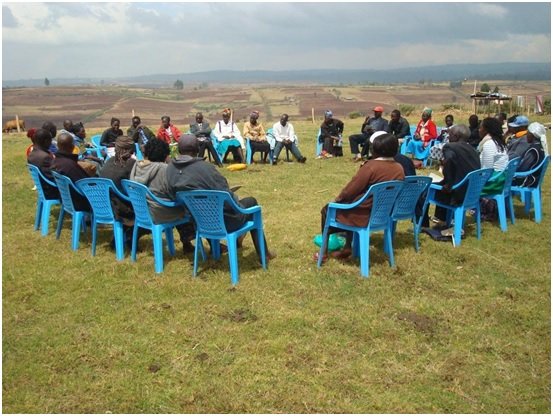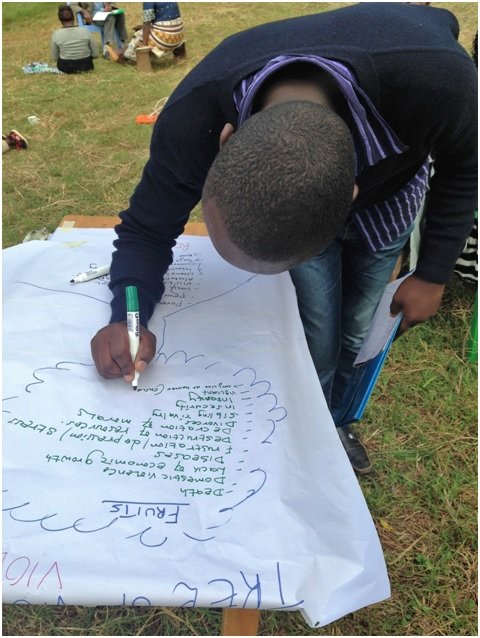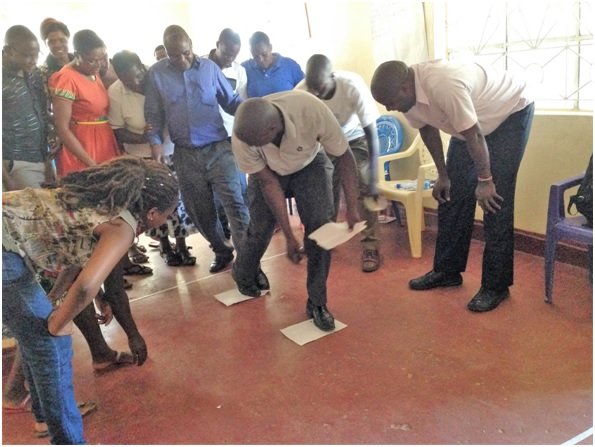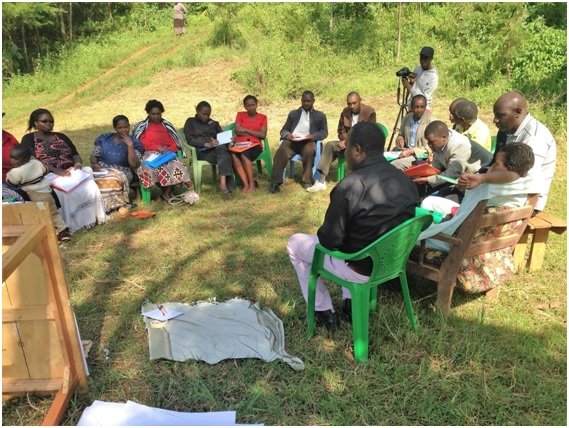By Getry Agizah | TCSC/FCPT Coordinator
Pain that is not Transformed is Transferred
Report on Work on Mt. Elgon.
Overall objective of the project
To build an all-inclusive society that understands peace as a way of life and create a support network healing through trainings, dialogue and negotiation
Specific objectives
BACKGROUND INFORMATION
Many communities in Kenya are faced with high levels of trauma and insecurity, Mt. Elgon is among the many communities which are struggling with the aftermaths of tribal clashes which were as a result of land disputes. The effects of the clashes in the region includes:
Because of the many unresolved land issues, some of the aggrieved members of the community have ganged up to defend their land and named their group “Saboat Land Defense Force” (SLDF) under the leadership of one Wycliffe Matakwei. The gang terrorized its own kinsmen who were perceived to be sympathizers of the government. Women and children were adversely affected by this violence because of their vulnerability. Hence the mortality rate among children under five is high because accessing medical facility is a nightmare for them. One out 10 women die during delivery due to lack of post natal care and depend entirely on very inexperienced midwifes. The militia took hostage nearly all public facilities like schools, hospitals, public offices rendering them inaccessible. As a result children did not go to school; there were early marriages. Things were moving out of hand during the 2007 election when the whole country experienced post-election violence. The gang took advantage of this and propelled their agenda without fear. In fact they controlled all activities in the region by forcing people to choose one of their leaders who was in custody into an elective position. The government quickly intervened using the armed forces and resettled people. But they forgot to address the root causes. Four years later again violence erupted in Mt. Elgon. This time changing shape by not going to forest but rather targeting individuals and certain locations. This has caused a lot of fear forcing people to leave their home for safety.
With this community undergoing all these kinds of injustices, Transforming Community for Social Change did the following interventions:
2. Listening Sessions
3, Community dialogues
Introductions
A total of fourteen workshops were conducted including one mediation, 7 HROC, and 6 AVP workshops. A total of 336 people were reached during the trainings with 182 male and 154 female. The choice of venue was based on areas that were hotspots and also points where small and light weapons proliferated from the neighboring countries. The participants for the training were:
The project ran for approximately three months.
Interventions
a) Alternative to Violence Program (AVP)
The alternative to violence program (AVP) is a grass root, volunteer based program dedicated to reducing violence in our lives, homes, schools, prisons and in society at large. AVP enables participants to deal with a potentially violent situation in a new and creative way. It provide space for people to transform conflict into a win –win situation. The workshops are structured in a way that participants are able to cover AFFIRMATION, COMMUNICATION, TRUST AND COMMUNITY BUILIDING, and CREATIVE CONFLICT RESOLUTION which are the main building blocks to the program. AVP uses shared experiences of participants, interactive exercises, games and role plays to examine how people respond to situations where injustices, prejudice, frustrations and anger can lead to aggressive behaviours and violence.
AVP can help one to:
AVP is anchored in some philosophy among them:
AVP has three levels
Understanding and believing in yourself and respecting others
Building trust and maintaining good relationships
Communicating well
Handling and managing strong emotions
Explores conflict, nonviolence in more depth while building on skills developed in level one
Usually participants co-operate to choose the themes of level two
Participants are chosen right from the basic training and oriented to become trainer
b) HEALING AND REBUILIDING OUR COMMUNITIES (HROC)
Why HROC ?
The basic level is usually done in three days.
The first day is committed to looking at “trauma”---its definition, causes, symptoms and its consequences. It also gives participants an opportunity to differentiate between normal stress and traumatic stress and have an in-depth awareness of self through the Johar’s window. The second day which is usually an emotional day focuses on loss, grief and mourning and gives participants space to share their personal loss. This day also reflects on anger and how people can respond to it constrictively. The last day looks at trust and mistrust and how people can rebuild trust in communities where such a history of awful things happened. The basic workshop is the corner stone in a larger program designed to build community capacity to respond to widespread trauma and strengthen inter-connection’s and reduce isolations.
HROC just like AVP is anchored in its philosophies:
After the trainings there is usually a one day follow up and community celebration that bring everyone together who has gone through the training. It also helps in identifying people who will walk with those that have already started the journey of healing commonly known as “healing companions.”
Transformative mediation
Mediation is a process in which a third party works with parties in a conflict to help them change the quality of their conflict interaction from negative and destructive to positive and constructive, as they discuss and explore various topics and possibilities for resolution.
Transformative mediation describes violence as a crisis in human interactions and parties need help in overcoming this crisis and restoring constructive interventions.
The main objective of the training:
Why choose transformative mediation with its theory of conflict?
v Human beings are believed to be inherently social or connected beings, motivated by a moral impulse to act with both strength and compassion, to be neither victim or victimizer, to interact humanely with each other in all their relation including conflict.
v Human beings have inherent capacities for both self-determined choice and responsiveness to others, even when confronted with adverse circumstances. Thhis enables them to achieve their desire for morally humane conflict interaction
v Because what motivates and matters most to us as human beings is morally humane interactions with others, the most salient meaning of conflict is a crisis in human interactions that tends to generate destructive interactions
v The most important product of conflict intervention is a change in the quality of the conflict interaction itself from destructive to constructive, negative to positive regardless of the specific substantive outcome
This training is participatory and a lot of mediation practice is employed to enable participants to have an in-depth understanding of the procedures to be followed. Three core values are insisted in the entire training for a mediator:
v Attend
The mediator pays close attention to the unfolding conversation, in order to identify opportunities for empowerment and recognition as they may arise
v Monitor
The mediator thinks before intervening, in order to monitor his or her motivations for intervening and to suppress any urges to be directive
v Respond
The mediator responds when appropriate, only to support the parties own efforts to make paradigm shift
Some of the key things that participant need to understand during the mediation process are;
Observations during the project
Achievements
Challenges
Recommendations
Next plans
Testimonies
“I stayed happily in my marriage for 33 years. One evening as I was cleaning my bedroom I found a bottle under the bed. I picked it up and read the label. To my surprise I realized that it contained antiretroviral drugs. I was shocked and tattered completely not knowing what to do. I sat on the bed confused just to be awakened by my husband entering in. Seeing what I was holding in my hand, he snatched it and became furious and chased me away. Luckily my sister came to my rescue. After being given information by a neighbor, she took me for testing and I was found to be HIV positive and was placed on drugs immediately. It took me time to accept the reality and that deteriorated my health. I have been struggling with that condition for the last 13 years and I have never spoken to my husband neither have I forgiven him “said Merciline.
“I grew up together with my brothers and sisters and we had a very good relationship. As years went by my brother joined the police force and I remained home doing farming. We helped each other very well. Life started being a challenge at the village and I asked my brother if I could join him at the city to some casual jobs on which he agreed.
“One morning I took a bus and set off to Nairobi. Since it was my first time to the city I had to ask for directions to where my brother was. When I arrived at the police camp, my brother was not there and I was welcomed by a female police who was there. She kept on asking me questions pertaining to our relationship which surprised me.
“He came in 30 minutes later and the lady asked me to wait for him outside. I was shocked when my real brother passed me without even greeting me. At first I thought that he did not recognize me because of the hat I was wearing, but that was not the case. I removed the hat and followed him calling his name and that fell on a deaf ear. I was left wondering what to do next since it was getting late. So I decided to follow him to his house and I forced myself in and sat near the door. He cooked and ate alone without even looking or saying anything to me. After him finishing eating the next thing I saw was him throwing my bag outside and chased me with a gun threating to shoot me. I slept on a curb till morning. To date I still live with bitterness.” David
“I am a pastor and I had known that by virtue of my profession I am the best mediator in any conflict, but today this theory has proved me wrong thanks to the organizers of this forum” Lunani
Project reports on GlobalGiving are posted directly to globalgiving.org by Project Leaders as they are completed, generally every 3-4 months. To protect the integrity of these documents, GlobalGiving does not alter them; therefore you may find some language or formatting issues.
If you donate to this project or have donated to this project, you can recieve an email when this project posts a report. You can also subscribe for reports without donating.




